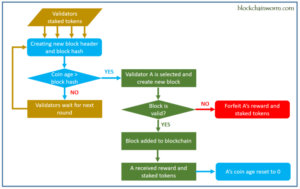Page Contents :
Where Proof Of Stake Came From And its Evolution
Consensus mechanisms are critical to the success of distributed cryptocurrency networks because they allow them to operate without a central authority.
The Proof-of-Work ![]() consensus mechanism consumes a lot of energy, and the transaction fee becomes very high, making it impossible to support large-scale transactions.
consensus mechanism consumes a lot of energy, and the transaction fee becomes very high, making it impossible to support large-scale transactions.

Proof of Stake (PoS) is one such alternative.
Let’s take a look at the evolution of PoS.
The idea of Proof-of-Stake was initially brought out on July 11, 2011, by a user named Quantum Mechanic in a BitcoinTalk thread ![]() .
.
Among the schemes, such as the replacement of computing power weights by currency holdings, delegation, and reward distribution, form the idea of the Proof-of-Stake.
The evolution of the PoS consensus mechanism has gone through three stages.
Now let’s take a look at how these three stages differ from one another:
The first stage is represented by Peercoin, a hybrid consensus model combining PoW and PoS mechanisms.
On August 19, 2012, Peercoin, the first blockchain project based on the PoS consensus, was launched.
In consensus, blocks are forged in a similar way to PoW, and nodes participating in block production need to perform a certain amount of hash value calculation.
The “Coin Age” concept is the foundational part of the Peercoin consensus protocol.
To reach a consensus, producers are chosen based on coin age and adopted the incentive method of equity holders.
The second stage is the Pure PoS consensus of Nextcoin (Nxt), which uses the number of tokens to achieve consensus.
The Nextcoin 100% Pure Proof-of-Stake Fundraise project was launched on September 28, 2013, by an account with the username BCNext.
Pure PoS mining only requires a small amount of staked tokens.
And the consensus mechanism chooses the block forger (validator) based on the stake held by the node (the number of holdings multiplied by the holding time).
The higher the stake ratio, the higher the probability of being selected as a block forger (validator).
There is no need to use energy to perform calculations because nodes are not required to compute hash values during the block forger election process.
As a result, the PoS mechanism’s requirement for staked tokens increases the cost of a 51% attack, which reduces the risk of a 51% attack.
However, in the PoS mechanism, new attacks arise, such as the Nothing At Stake problem.
The idea of the coin age is brought again in the third stage.
It introduces a Pledge and Penalty mechanism in response to the problems brought up by the pure PoS consensus mechanism.
Ethereum Casper stands for this new PoS consensus type.
Block validators take part in the Nothing At Stake problems by staking tokens and punishing malicious nodes to ensure the security and consistency of the system.
Its consensus usually uses PoS as part of the consensus algorithm.
Blocks are forged using PoS, and blocks are verified using the Byzantine Fault Tolerance (BFT) algorithm.
They all employ an “equity economy“, in which nodes can obtain block rewards according to the proportion of equity they held by participating in the network consensus.
∮ Nothing At Stake Solve With Pledge And Penalty Mechanism
When network delays, malicious attacks, or other reasons cause a PoS consensus system to fork.
PoS miners (validators) can simultaneously mine block on both chains at no cost (nothing at stake).
Making it feasible to forge blocks and reap “all the benefits”.
Although this goes against the consensus protocol, forging blocks simultaneously on different chains doesn’t cost miners (validators) very much at all.
And since validators (miners) don’t have to pay to join the new forked chain, the chain that wins in the end can bring them considerable income.
The Casper protocol requires miners (validators) to take part in mining using staked tokens to address the “nothing at stake” problem.
This part of the staked tokens is used to ensure the honest behavior of the miners (validators).
If the miners (validators) try to broadcast blocks on both chains, their staked tokens will get slashed as a penalty.
A miner (validator) will be rewarded with block rewards and transaction fees if he successfully creates and broadcasts a verified block.
In this case, the issue of nothing at stake is avoided via the pledge and penalty mechanism.
The miners (validators) are completely responsible for maintaining the nodes’ security and consensus.
∮ How Byzantine Fault Tolerance Mechanism Reaches Consensus
The Byzantine problem is a consensus problem, in which the generals of the Byzantine Empire’s army must unanimously decide whether to attack an enemy city.

Since there are traitors among the generals and these generals are very far apart.
Traitors can trick loyal generals to act differently or confuse them so they can’t come to a consensus.
They could only win if they all attack at the same time after a consensus is reached.
The assumption of the Byzantine system is divided into Loyal (Honest) and Malicious (Byzantine) nodes.
The malicious node typically reacts in the following ways to obstruct the transmission of real information and the achievement of consensus
- Not replying to the result.
- Responding with wrong information.
- Delivering inconsistent information.
The network system issues are also included in the assumption of the Byzantine system:
- Nodes can react arbitrarily, and nodes can also collude.
- Errors between nodes are uncorrelated.
- Nodes communicate through asynchronous networks When connected, messages in the network may be lost, chaotic, or delayed to arrive.
- The information transmitted between nodes can be known by a third party, but cannot be tampered with or forged.
The above model summarizes an overview of various unknown reactions caused by software and hardware errors, network congestion, and malicious attacks in real networks.
The group of algorithms developed to overcome this problem is known as the BFT algorithms.
In the BFT consensus mechanism, the number and identity of nodes in the network must be determined in advance.
It can’t work like the PoW consensus process where anyone can join or exit mining at any time since the network needs to be initialized every time a node joins or exits.
As a result, the network using the BFT algorithm cannot carry a large number of nodes, and its upper limit is 100 nodes.
The leader (master) node broadcasts the message to other backup nodes.
As long as the majority of honest nodes confirm the message, the consensus of the whole network can be reached, which means that the transaction is successful.
That is to say, the BFT mechanism is a consensus mechanism that adopts the “minority obeying the majority voting system” to reach the consensus.
The consensus will be reached if more than 66% of the backup nodes concur with the leader node plan, which means that the minority will obey the principle of the majority.
How To Mine Through The PoS Mechanism?
To forge new blocks using the PoS mechanism, the validator must show ownership of a certain number of tokens.

- You must own or purchase a certain amount of tokens to participate in mining.
- In the PoS consensus mechanism, mining nodes are referred to as “validators”.
Competitors must stake a certain amount of tokens before the competition to qualify for validators. - The “coin age” concept is introduced by the PoS mechanism. The staked token and coin age will be used by the system to choose the validator.
- All transactions are verified by validators, who then publish new blocks.
A new block is added to the blockchain after being approved by network nodes. - Validators will get back the staked tokens and rewards, and their coin age will also be reset to 0. This puts him at “low priority” in the next validator selection.
- Then enter a new validator competition round.
∮ Calculation For Coin Age
The PoS consensus mechanism randomly selects the validator to forge a new block.
You must hold the token for at least 30 days to qualify for the validator. Each token generates one coin age each day.
The coin age is also used to calculate the reward for forging new blocks.
The following is how coin age is calculated:
Coin Age = Number of staked days × Number of staked coins
If you have 100 tokens and have held them for 30 days, your coin age is 100 x 30, which is 3,000.
At this point, your coin age will be set to 0 if you forge a new PoS block.
You will also receive interest based on the coin age, and the interest reward formula is as follows:
Interest = Coin age × Annual interest rate of the token ÷ 365
For instance, if your staked tokens have a 5% annual interest rate, you would receive a reward of 3,000 x 5% x 365 = 0.41 tokens.
Resetting the coin age to 0 will solve the issue of nodes dominating the blockchain due to their massive quantity of staked tokens, increasing network security.
The annual interest rate of the staked tokens is not fixed.
Each token has a different annual interest rate, which is variable every day.
For instance, PPCoin offers an annual interest rate of 1%, YaCoin 5%, and CosmosCoin 1.5%.
What Are The Advantages Of PoS?
Low Energy Consumption:
Nodes use extremely little energy since they stake tokens to reach consensus and forge new blocks.
Decentralization:
It encourages Decentralization because its rewards are proportional to the amount of stake, and the minimum staking threshold is low, allowing most token holders to join.
High security:
Because attacking a network requires a new set of staked tokens and must have 51% equity, thereby reducing incentives for the attack, and making the network more secure.
What Are The Disadvantages Of PoS?
Weakened Decentralization (Monopolization):
Those with a large number of tokens have a better chance of being chosen to forge the new block and reap a majority of all future coins.
Over time may result in the network to become centralized.
New Consensus Mechanism:
Since the PoS is a relatively new technology, it is easy to generate some new problems in the application process. Such as nothing at stake, long-range attack, etc.
Summarize
Overall, the evolution of PoS has seen substantial growth, supported by numerous players.
In the next post, we’ll discuss Delegated Proof-of-Stake (DPoS) and some of its characteristics.




